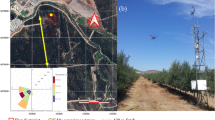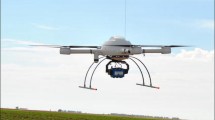Abstract
This study was conducted to model the fraction of intercepted photosynthetically active radiation (fIPAR) in heterogeneous row-structured orchards, and to develop methodologies for accurate mapping of the instantaneous fIPAR at field scale using remote sensing imagery. The generation of high-resolution maps delineating the spatial variation of the radiation interception is critical for precision agriculture purposes such as adjusting management actions and harvesting in homogeneous within-field areas. Scaling-up and model inversion methods were investigated to estimate fIPAR using the 3D radiative transfer model, Forest Light Interaction Model (FLIGHT). The model was tested against airborne and field measurements of canopy reflectance and fIPAR acquired on two commercial peach and citrus orchards, where study plots showing a gradient in the canopy structure were selected. High-resolution airborne multi-spectral imagery was acquired at 10 nm bandwidth and 150 mm spatial resolution using a miniaturized multi-spectral camera on board an unmanned aerial vehicle (UAV). In addition, simulations of the land surface bidirectional reflectance were conducted to understand the relationships between canopy architecture and fIPAR. Input parameters used for the canopy model, such as the leaf and soil optical properties, canopy architecture, and sun geometry were studied in order to assess the effect of these inputs on canopy reflectance, vegetation indices and fIPAR. The 3D canopy model approach used to simulate the discontinuous row-tree canopies yielded spectral RMSE values below 0.03 (visible region) and below 0.05 (near-infrared) when compared against airborne canopy reflectance imagery acquired over the sites under study. The FLIGHT model assessment conducted for fIPAR estimation against field measurements yielded RMSE values below 0.08. The simulations conducted suggested the usefulness of these modeling methods in heterogeneous row-structured orchards, and the high sensitivity of the normalized difference vegetation index and fIPAR to background, row orientation, percentage cover and sun geometry. Mapping fIPAR from high-resolution airborne imagery through scaling-up and model inversion methods conducted with the 3D model yielded RMSE error values below 0.09 for the scaling-up approach, and below 0.10 for the model inversion conducted with a look-up table. The generation of intercepted radiation maps in row-structured tree orchards is demonstrated to be feasible using a miniaturized multi-spectral camera on board UAV platforms for precision agriculture purposes.

















Similar content being viewed by others
References
Alton, P. B., North, P. R., & Los, S. O. (2007). The impact of diffuse sunlight on canopy light-use efficiency, gross photosynthetic product and net ecosystem exchange in three forest biomes. Global Change Biology, 13, 1–12.
Asrar, G., Myneni, R. B., & Choudbhury, B. J. (1992). Spatial heterogeneity in vegetation canopies and remote sensing of absorbed photosynthetically active radiation: A modelling study. Remote Sensing of Environment, 41, 85–103.
Barton, C. V. M., & North, P. R. J. (2001). Remote sensing of canopy light use efficiency using the photochemical reflectance index. Model and sensitivity analysis. Remote Sensing of Environment, 78, 264–273.
Berni, J. A. J., Zarco-Tejada, P. J., Suarez, L., & Fereres, E. (2009). Thermal and narrow-band multispectral remote sensing for vegetation monitoring from an unmanned aerial vehicle. IEEE Transactions on Geoscience and Remote Sensing, 47(3), 722–738.
Bouguet, J. (2001). Camera calibration toolbox for Matlab. http://www.vision.caltech.edu/bouguetj/calib_doc. Accessed January 2012.
Choudhury, B. J. (1987). Relationships between vegetation indices, radiation absorption, and net photosynthesis evaluated by a sensitivity analysis. Remote Sensing of Environment, 22, 209–233.
Daughtry, C. S. T., Gallo, K. P., & Bauer, M. E. (1983). Spectral estimates of solar radiation by corn canopies. Agronomy Journal, 75, 527–531.
Daughtry, C. S. T., Gallo, K. P., Goward, S. N., Price, S. D., & Kustas, W. P. (1992). Spectral estimates of absorbed radiation and phytomas production in corn and soybean canopies. Remote Sensing of Environment, 39, 141–152.
De Wit, C. T. (1959). Potential photosynthesis of crop surfaces, Netherlands. The Journal of Agricultural Science, 7, 141–149.
Disney, M. I., Lewis, P., & North, P. R. J. (2000). Monte Carlo ray tracing in optical canopy reflectance modelling. Remote Sensing Reviews, 18(2–4), 163–196.
Gallagher, J. N., & Biscoe, P. V. (1978). Radiation absorption, growth and yield of cereals. The Journal of Agricultural Science, 91, 47–60.
Goward, S. N., & Huemmrich, K. F. (1992). Vegetation canopy PAR Absorptance and the normalized difference vegetation index: An assessment using the SAIL model. Remote Sensing of Environment, 39, 119–140.
Gueymard, C.A. (2005). SMARTS Code, Version 2.9.5 user’s manual solar consulting services. Online PDF document from http://www.nrel.gov/rredc/smarts/. Accessed January 2012.
Hall, F. G., Huemmrich, K. F., Goetz, S. J., Sellers, P. J., & Nickerson, J. E. (1992). Satellite remote sensing of surface energy balance: Success, failures, and unresolved issues in FIFE. Journal of Geophysical Results, 97, 19061–19089.
Huemmrich, K. F. (2001). The GeoSail model: A simple addition to the SAIL model to describe discontinuous canopy reflectance. Remote Sensing of Environment, 75, 423–431.
Huemmrich, K. F., & Goward, S. N. (1997). Vegetation canopy PAR Absorptance and NDVI: An assessment for ten species with SAIL model. Remote Sensing of Environment, 61, 254–269.
Huete, A. R. (1989). Soil influences in remotely sensed vegetation canopy-spectra. In G. Asrar (Ed.), Theory-applications of optical remote sensing (pp. 107–141). New York: Willey.
Huete, A. R., Jackson, R. D., & Post, D. F. (1985). Spectral response of a plant canopy with different soil backgrounds. Remote Sensing of Environment, 17, 37–53.
Hunt, R. E. (1994). Relationship between woody biomass & PAR conversion efficiency for estimating net primary production from NDVI. International Journal Remote Sensing, 15, 1725–1730.
Jackson, J. E. (1980). Light interception and utilization by orchard systems. Horticultural Reviews, 2, 208–267.
Kempeneers, P., Zarco-Tejada, P. J., North, P. R. J., De Backer, S., Delalieux, S., Sepulcre-Cantó, G., et al. (2008). Model inversion for chlorophyll estimation in open canopies from hyperspectral imagery. International Journal of Remote Sensing, 29(17–18), 5093–5111.
Koetz, B., Baret, F., Poilvé, H., & Hill, J. (2005). Use of coupled canopy structure dynamic and radiative transfer models to estimate biophysical canopy characteristics. Remote Sensing of Environment, 95(1), 115–124.
Lang, A. R. G. (1987). Simplified estimate of leaf area index from transmittance of the sun’s beam. Agricultural and Forest Meteorology, 41, 179–186.
Lang, A. R. G., Xiang, Y., & Norman, J. M. (1985). Crop structure and the penetration of direct sunlight. Agricultural and Forest Meteorology, 35, 8–101.
Lemeur, R. (1973). A method for simulating the direct solar radiation regime in sunflower, Jerusalen artichoke, corn and soybean canopies using actual stand structure data. Agricultural and Forest Meteorology, 12, 229–247.
Li-Cor Inc. (1984). Li-Cor model 1800-12 integrating sphere instruction manual (Revision 1984). Li-Cor Incorporated, Lincoln, NE, Publication No. 8305-0034.
Loomis, R. S., & Williams, W. A. (1963). Maximum crop productivity: An estimate. Crop Science, 3, 67–72.
Mariscal, M. J., Orgaz, F., & Villalobos, F. J. (2000). Modelling and measurement of radiation interception by olive canopies. Agricultural and Forest Meteorology, 100, 183–197.
Monteith, J. L. (1972). Solar radiation and productivity in tropical ecosystems. Journal of Applied Ecology, 9, 747–766.
Moran, M. S., Inoue, Y., & Barmes, E. M. (1997). Opportunities and limitations for image-based remote sensing in precision crop management. Remote Sensing of Environment, 61(3), 319–346.
Moriondo, M., Maselli, F., & Bindi, M. (2007). A simple model of regional wheat yield based on NDVI data. European Journal of Agronomy, 26, 266–274.
Myneni, R. B., & Williams, D. L. (1994). On the relationships between FAPAR and NDVI. Remote Sensing of Environment, 49, 200–211.
North, P. R. J. (1996). Three-dimensional forest light interaction model using a Monte Carlo method. IEEE Transactions on Geoscience and Remote Sensing, 34(4), 946–956.
North, P. R. J. (2002). Estimation of f APAR , LAI, and vegetation fractional cover from ATSR-2 imagery. Remote Sensing of Environment, 80, 114–121.
Pinty, B., Widlowski, J. L., Gobron, N., & Verstraete, M. M. (2002). Uniqueness of multi-angular information—Part 1: A surface heterogeneity indicator from MISR. IEEE Transactions on Geosciences and Remote Sensing, 40, 1560–1573.
Prieto-Blanco, A., North, P. R. J., Barnsley, M. J., & Fox, N. (2009). Satellite-driven modelling of net primary productivity (NPP): theoretical analysis. Remote Sensing of Environment, 113, 137–147.
Robinson, T., & Lakso, A. (1991). Bases of yield and production efficiency in apple orchard system. Journal of the American Society for Horticultural Science, 116(2), 188–194.
Ross, J. (1981). The radiation regime and architecture of plant stands. The Hague: W. Junk.
Suárez, L., Zarco-Tejada, P. J., Berni, J. A. J., González-Dugo, V., & Fereres, E. (2009). Modelling PRI for water stress detection using radiative transfer models. Remote Sensing of Environment, 113, 730–744.
Suárez, L., Zarco-Tejada, P. J., González-Dugo, V., Berni, J. A. J., Sagardoy, R., Morales, F., et al. (2010). Detecting water stress effects on fruit quality in orchards with time-series PRI airborne imagery. Remote Sensing of Environment, 114, 286–298.
Villalobos, F. J., Orgaz, F., & Mateos, L. (1995). Non-destructive measurement of leaf area in olive (Olea europaea L.) trees using a gap inversion method. Agricultural and Forest Meteorology, 73, 29–42.
Weiss, M., Baret, F., Myneni, R. B., Pragnère, A., & Knyazikhin, Y. (2000). Investigation of a model inversion technique to estimate canopy biophysical variables from spectral and directional reflectance data. Agronomie, 20(1), 3–22.
Widlowski, J.-L. (2010). On the bias of instantaneous FAPAR estimates in open-canopy forests. Agricultural and Forest Meteorology, 150, 1501–1522.
Widlowski, J.-L., Pinty, B., Disney, M., Gastellu-Etchegorry, J.-P., Lavergne, T., Lewis, P. E., et al. (2008). The RAMI on-line model checker (ROMC): A web-based benchmarking facility for canopy reflectance models. Remote Sensing of Environment, 112(3), 1144–1150.
Widlowski, J.-L., Taberner, M., Pinty, B., Bruniquel-Pinel, V., Disney, M., Fernandez, R., et al. (2007). Third radiation transfer model intercomparison (RAMI) exercise: Documenting progress in canopy reflectance models. Journal of Geophysical Research, 112, D09111.
Zarco-Tejada, P. J., Berjón, A., López-Lozano, R., Miller, J. R., Martín, P., Cachorro, V., et al. (2005). Assessing vineyard condition with hyperspectral indices: Leaf & canopy reflectance simulation in a row-structured discontinuous canopy. Remote Sensing of Environment, 99, 271–287.
Zarco-Tejada, P. J., Berni, J. A. J., Suárez, L., & Fereres, E. (2008). A new era in remote sensing of crops with unmanned robots. SPIE Newsroom,. doi:10.1117/2.1200812.1438.
Zarco-Tejada, P. J., González Dugo, V., & Berni, J. A. J. (2012). Fluorescence, temperature and narrow-band indices acquired from a UAV platform for water stress detection using a micro-hyperspectral imager and a thermal camera. Remote Sensing of Environment, 117, 322–337.
Zhang, Q., Middleton, E. M., Margolis, H. A., Drolet, G. G., Barr, A. A., & Black, T. A. (2009). Can a satellite-derived estimate of the fraction of PAR absorbed by chlorophyll (FAPARchl) improve predictions of light-use efficiency and ecosystem photosynthesis for a boreal aspen forest? Remote Sensing of Environment, 113, 880–888.
Acknowledgments
Financial support from the Spanish Ministry of Science and Innovation (MCI) for the projects AGL2009-13105, CONSOLIDER CSD2006-67, and AGL2003-01468 is gratefully acknowledged, as well as the Junta de Andalucía-Excelencia AGR-595 and FEDER. M.L. Guillén-Climent was supported by a grant JAE of CSIC, co-funded by the European Social Fund. Technical support from UAV Navigation, Tetracam Inc. and UAV Services and Systems for the airborne requirements are acknowledged. A. Vera, D. Notario, R. Romero, and A. Hornero are acknowledged for technical support in field and airborne campaigns.
Author information
Authors and Affiliations
Corresponding author
Rights and permissions
About this article
Cite this article
Guillen-Climent, M.L., Zarco-Tejada, P.J., Berni, J.A.J. et al. Mapping radiation interception in row-structured orchards using 3D simulation and high-resolution airborne imagery acquired from a UAV. Precision Agric 13, 473–500 (2012). https://doi.org/10.1007/s11119-012-9263-8
Published:
Issue Date:
DOI: https://doi.org/10.1007/s11119-012-9263-8




